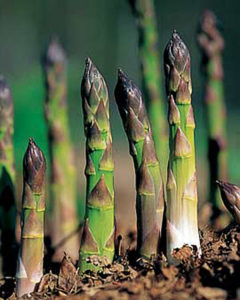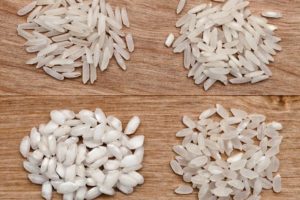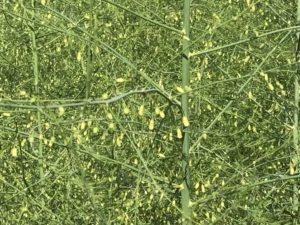 THE FIRST ASPARAGUS OF THE YEAR
THE FIRST ASPARAGUS OF THE YEAR
TODAY’S LESSON: Asparagus is one of the first vegetable crops to stick its head out of the cold winter ground and be swept off to market. The asparagus crop we enjoy starts first out of Mexico and follows the Spring sun northward across the United States and into the southern reaches of Canada. Today we will explore the full flavor of young, tender asparagus captured in a delightful risotto or rice stew.
WHAT EXACTLY IS ASPARAGUS? Asparagus is a member of the lily family which includes onions and leeks. The perennial plant begins producing these edible sprouts in the third year and continues into its prime for about 6 to 8 years. The higher cost comes from the irregular growth which necessitates hand harvesting. Asparagus is high in vitamins B6, C, thiamin, and folacin. It is also abundant with glutathione, a powerful anticarcinogen, and antitoxin. Asparagus is low in calories, about 20 in 6 large spears.
WHAT EXACTLY IS RISOTTO? Risotto refers to both the dish and the technique used in cooking an Italian variety of rice that creates its special creamy texture. The variety of rice is essential to creating the creamy starch texture while maintaining an al dente texture in the rice grain itself. The creamy texture of this rice dish comes from the outer starch layers of these specific varieties of rice grains which are released during cooking to mix with the stock, thus thickening the liquid into a sauce-like consistency. The balance between too much liquid like soupiness and the thickened creamy texture is controlled by the addition of liquids and the length of cooking with the perfect result of a creamy texture.
WHY ASPARAGUS TASTES SO GOOD: Asparagus is rich in UMAMI proteins. UMAMI is the fifth taste sense along with SWEET, BITTER, SALTY AND SOUR. These Umami taste receptors are stimulated by certain specific amino acids that are the core building blocks of proteins.
SELECTING YOUR ASPARAGUS: Pick the freshest asparagus for the best flavor and texture. Use the asparagus immediately since the natural sugars begin to convert into tough, indigestible fibers in the skin as soon as it is picked, hence the need to peel the larger not so fresh spears. Some people prefer the larger spears while others like me choose the smaller pencil-size spears. I prefer the little guys since they have a more pronounced flavor and don’t need to be peeled (I’m lazy).
 WHICH RICE DO YOU USE? The traditional rice for risotto comes from Northern Italy, most typically Arborio. For best results, select “Riso Fino” or the best “Riso Superfino” Italian Arborio varieties, both available in specialty food markets and grocers.
WHICH RICE DO YOU USE? The traditional rice for risotto comes from Northern Italy, most typically Arborio. For best results, select “Riso Fino” or the best “Riso Superfino” Italian Arborio varieties, both available in specialty food markets and grocers.
SELECTING YOUR POT: Risotto is best made in saucepans rather than skillets. For the best results, the risotto should lay a couple of inches deep in the saucepan to maximize the starch gel formation. Skillets are flatter, thus allowing the risotto to be quite shallow in the pan promoting evaporation of the liquid and hinders the starch development. Use a wooden spoon or spatula for stirring the risotto. It is thought that the wooden spoon does not break up the rice grains as much as say a metal spoon.
PREPARING YOUR RISOTTO-THE KEY STEPS:
1. Saute the onion family until tender in olive oil. Add the rice and cook until hot to the touch, about 3 or 4 minutes. This firms the exterior of the rice which helps control the moisture absorption.
2. Add enough liquid to cover the rice and return to a simmer. Stir occasionally for even liquid absorption replacing the liquids as they are absorbed.
3. Add garnish vegetables or nutrients towards the end of the cooking process to preserve their individual identity.
4. Finish the risotto with cheese and, if you like, a little butter OFF of the heat. Stir in and serve immediately. Do not ever return to the fire after the cheese has been added.
TRICKS OF THE TRADE: For a richer vegetable flavor and pale green color in the rice combine your stock, cooked asparagus, and spinach, blending until smooth. The strained enriched stock adds deeper flavor and a bright green hue to the dish, perfect for St. Patrick’s Day.
TRY YOUR TECHNIQUE: Here’s a great simple asparagus risotto to welcome the change in the weather.

Asparagus in Bloom Northern Michigan
SPRING ASPARAGUS RISOTTO
Makes 4 servings
2 pounds asparagus
1/2 pound spinach, picked stems and washed
4 cups of vegetable stock or light poultry stock, hot
1 tablespoon extra virgin olive oil
8 large shallots, peeled and diced fine
1-1/2 cups Violone nano or Arborio rice
1/2 cup white wine
sea salt
freshly ground black pepper
1/4 cup snipped fresh chives
1/2 cup finely grated Parmesan cheese
To Prepare the Ingredients: In a large pot of boiling salted water add the
asparagus cooking until al dente (firm to the bite), about 3 or 4 minutes
depending on the size of your asparagus; Do not overcook. Transfer to a
colander, drain and cool slightly under running cold water to stop the
cooking. Cut the upper 2 inch tops from the asparagus and reserve for
garnish. Cut the remaining asparagus into 1-inch pieces.
In a large blender add some of the asparagus stems and a handful of the
spinach. Ladle the simmering hot vegetable stock into the blender to cover the vegetables. Cover the blender with a vented top and a towel over to prevent any spillage of the hot liquid when processing. Carefully pulse the blender pureeing the ingredients until smooth. Transfer to a sieve over a bowl and strain the coarse asparagus fibers from the liquids. Repeat with the remaining liquid and vegetables. Keep warm.
To Make the Risotto: In a large saucepan, heat the olive oil over medium-high heat. Add the shallots, cooking until tender about 4 minutes. Add the rice and cook until warm to the back of the hand, about 3 minutes. Carefully add the white wine to the rice and allow to evaporate. Add 2 cups of the hot stock and bring to a simmer stirring frequently. Add salt to your taste. Cook the rice until the liquid has reduced to coat the rice, about 6 minutes. Add about 3/4 cup of the stock and allow to reduce to coat the rice, about 3 or 4 minutes each time. Repeat adding small amounts of the hot stock until the rice becomes quite creamy yet still al dente (firm to the bite) and all the liquid is about used. Add the last of the stock, the asparagus tips, and the chives cooking until creamy and thickened. Adjust the seasoning with salt and pepper to your taste. Remove from the heat. Add the Parmesan, stirring to combine. Spoon immediately into warm rimmed soup bowls or plates. Serve immediately.
VANILLA CARAMELIZED MICHIGAN ASPARAGUS & ASPARAGUS THREAD SALAD
Makes 4 servings
Prep Time 15 minutes Cooking Time 15 minutes
1 pound asparagus. Lower 1/4 of stem removed, peeled if necessary
1 lemon juiced, rind grated very fine
1 teaspoon Vanilla extract
2 tablespoons Carotino or Olive Oil
Sea salt (C=0g)
Tellicherry Black pepper to your taste
1/4 cup snipped fresh chives
4 tablespoons unsalted butter
1 tablespoon minced fresh ginger
1 vanilla bean, cut in half lengthwise, scrape the pulp and seeds
from the bean with the back of a pairing knife
½ cup dry white wine
1/4 cup magenta micro herbs
Prepare the asparagus by selecting 20 of the best spears, trimming the stem length to fit your serving plate. Cut the remaining asparagus spears into fine julienne lengthwise with a sharp knife or green bean “frencher” into threads In a small bowl combine the lemon juice, vanilla extract, and oil, whisking to combine. Season generously with salt, pepper and half of the chives. Reserve.
To serve: In a large nonstick pan heat the butter over medium heat. Add the ginger cooking until tender, about 3 minutes. Add the asparagus spears cooking until caramelized, about 6 minutes turning as necessary. Add the vanilla bean pulp and white wine cooking until reduced to coat the asparagus. Season generously with salt and pepper. Divide and artistically arrange the spears in the center of your serving plate. Spoon the pan juices over the spears.
In a medium bowl combine the asparagus threads, magenta herbs and vanilla
vinaigrette tossing to combine. Divide and mound the asparagus salad atop
the spears. Sprinkle with the remaining chives and a little Tellicherry Pepper.
Jimmy Schmidt